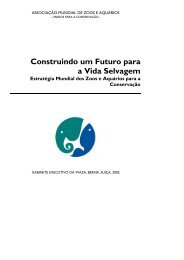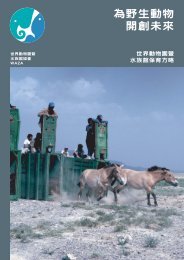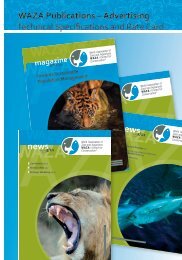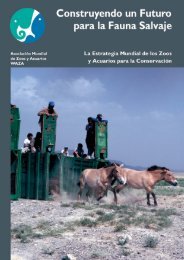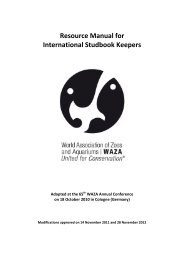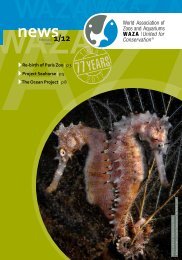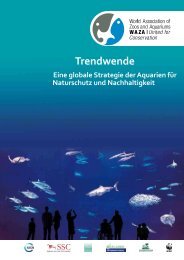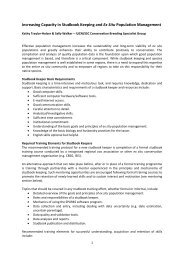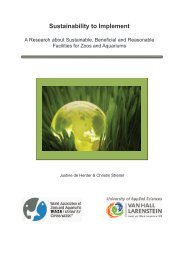Towards Sustainable Population Management - Waza
Towards Sustainable Population Management - Waza
Towards Sustainable Population Management - Waza
You also want an ePaper? Increase the reach of your titles
YUMPU automatically turns print PDFs into web optimized ePapers that Google loves.
WAZA magazine Vol 12/2011<br />
Sarah Long 1 *, Candice Dorsey 2 & Paul Boyle 2<br />
Status of Association of Zoos<br />
and Aquariums Cooperatively<br />
Managed <strong>Population</strong>s<br />
Introduction<br />
The Association of Zoos and Aquariums<br />
(AZA) is one of the many zoo<br />
associations worldwide that is<br />
undergoing a renewed focus on the<br />
sustainability of its managed populations.<br />
Sustainability is generally<br />
characterised by population biologists<br />
as the ability of a population to<br />
maintain a stable size and healthy<br />
age structure through reproduction<br />
(if self-sustaining) or other means<br />
(importation from private facilities,<br />
other regions or the wild). Genetic<br />
diversity is often measured as a component<br />
of population viability, as<br />
genetically diverse populations are<br />
likely to be more resilient in adapting<br />
to environmental change and avoiding<br />
the negative effects of inbreeding<br />
depression (Frankham et al. 2002).<br />
Maintaining both demographic<br />
stability and gene diversity have long<br />
been part of cooperatively managed<br />
programmes in zoos and aquariums,<br />
including AZA’s Species Survival Plan®<br />
(SSP) and <strong>Population</strong> <strong>Management</strong><br />
Plan (PMP) programmes. Here, we<br />
present an examination of the current<br />
demographic and genetic status of<br />
AZA cooperatively managed Animal<br />
Programmes and an assessment of<br />
key indicators of the viability of these<br />
populations.<br />
1 <strong>Population</strong> <strong>Management</strong> Center,<br />
Lincoln Park Zoo, Chicago, IL, USA<br />
2 Association of Zoos and Aquariums,<br />
Silver Spring, MD, USA<br />
* E-mail for correspondence:<br />
slong@lpzoo.org<br />
As in other regions, population management<br />
in AZA depends upon a network<br />
of volunteer studbook keepers<br />
and species coordinators to collect,<br />
compile and validate pedigrees and<br />
life histories (birth/hatch dates and<br />
locations, transfer events, death<br />
dates and locations) for each individual<br />
of a cooperatively managed population<br />
and to coordinate animal and<br />
institutional needs with population<br />
goals. AZA is unique among regional<br />
zoo associations in having a staff of<br />
full-time professional population<br />
biologists assisting its cooperatively<br />
managed programmes. The AZA <strong>Population</strong><br />
<strong>Management</strong> Center (PMC)<br />
based at Lincoln Park Zoo in Chicago,<br />
IL provides a bridge between studbook<br />
data and the management plan<br />
by helping to improve data quality,<br />
conducting demographic and genetic<br />
analyses and integrating institutional<br />
needs and husbandry information<br />
into breeding and transfer recommendations.<br />
The transformation of<br />
studbook data into management<br />
plans is an essential step in population<br />
management, without which cooperative<br />
efforts towards population<br />
stability and genetic management<br />
are likely to falter. Since its inception<br />
in 2000, the PMC has provided<br />
scientific and logistical support to<br />
approximately 60% of AZA’s Animal<br />
Programmes, producing more than<br />
800 management plans for over 300<br />
populations. Some of the remaining<br />
populations are assisted by a small<br />
number of volunteer advisors, but<br />
over 150 AZA Animal Programmes<br />
have yet to receive any formal population<br />
management advice because<br />
they are newly designated, awaiting<br />
assistance from a population biologist,<br />
or lack a studbook database or<br />
a species coordinator.<br />
Despite all the organisational, institutional<br />
and scientific resources<br />
dedicated to these cooperatively<br />
managed programmes, AZA populations<br />
are facing challenges similar<br />
to zoo populations in other regions –<br />
limited space for expansion, loss of<br />
gene diversity, declining population<br />
sizes, incomplete data with which<br />
to manage the populations – all of<br />
which may threaten the ability of<br />
AZA-accredited zoos to meet their<br />
exhibit, education or conservation<br />
goals with these species. In an attempt<br />
to characterise the viability<br />
of AZA-managed populations, basic<br />
descriptive information was gathered<br />
from studbooks and management<br />
plans for 428 populations and results<br />
of demographic and genetic analyses<br />
conducted by the PMC have been<br />
summarised for 319 populations. Of<br />
particular interest are measures that<br />
provide insight into genetic and demographic<br />
health, such as founding<br />
population size, current population<br />
size, proportion of animals breeding<br />
and recent population growth rates.<br />
15<br />
»



